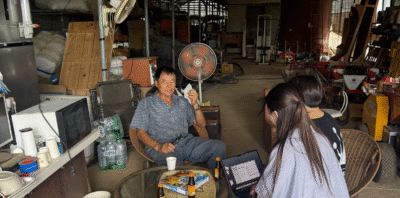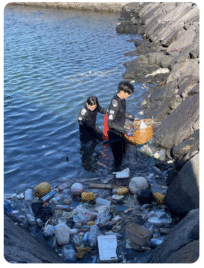Cleaning Up the Streets of Sinsa – A Day with Our Team
Seeing Beyond the Surface of Sinsa
Last weekend, our Spiritus team spent a day cleaning up the streets and back alleys of Sinsa-dong, Gangnam. Known for its fashionable streets, trendy cafés, and vibrant nightlife, Sinsa is one of Seoul’s busiest neighborhoods. But as soon as we stepped away from the main roads, we encountered a very different scene — hidden piles of litter tucked behind buildings, overflowing bins, and trash scattered along narrow alleys that most people rarely notice.
We came here with two clear goals. First, we wanted to collect as much waste as possible and make the area visibly cleaner. Second, we aimed to record and analyze data on the types and locations of the trash we collected. By understanding what kinds of waste are most common and where they tend to gather, we can design more targeted and effective cleanup efforts in the future.

On the Ground: What We Found and Where
Armed with gloves, large trash bags, and a strong sense of teamwork, we divided the area into smaller zones to cover more ground efficiently. We cleaned not only the main shopping streets but also service roads, parking lots, and the narrow alleyways behind restaurants.
Along the way, we discovered a wide range of waste, including:
- Plastic waste such as bottles, food packaging, and snack wrappers
- Aluminum cans, often from energy drinks or beer, tossed near convenience stores
- Paper cups from coffee shops, sometimes still containing leftover drinks
- General waste like tissues, cigarette packs, and small plastic bags
We also noticed some clear patterns:
- Delivery motorcycle waiting areas had high concentrations of drink containers and snack packaging.
- Corners near utility poles often contained cigarette butts and crumpled receipts.
- Back entrances of buildings were hotspots for takeout containers and discarded straws.
Observing these patterns helped us understand not just what kind of waste we were collecting, but why it was there in the first place.
The Data Behind the Cleanup
This cleanup was about more than simply picking up trash. Using a tracking app, we recorded the distance we covered, the number of items collected, and their categories. Over a 1.11 km route in 26 minutes, our team collected 138 pieces of waste.
Here’s the breakdown:
| Type of Waste | Percentage |
|---|---|
| Plastics | ~45% |
| Cans | ~20% |
| Paper | ~15% |
| General waste | ~20% |

The results revealed that plastic waste alone accounted for nearly half of what we collected. This highlights the urgent need for targeted action on single-use plastics in urban spaces like Sinsa.
By collecting and analyzing this data, we can now track changes over time, compare different cleanup sites, and measure the effectiveness of our ongoing efforts.

The Power of Teamwork
This cleanup was a true team effort. Each member played an essential role — spotting hidden trash, carrying collection bags, sorting items, and tracking data. Working together allowed us to cover more ground in less time and stay motivated throughout the process.
There were moments of laughter too, like when two people raced to pick up the same stray can. These small, joyful moments reminded us that even hard physical work can be rewarding and fun when shared as a team. And when one person grew tired, others stepped up with encouragement, keeping the energy high until every bag was full.
Reflections and Next Steps

Picking up litter may seem like a small action, but it has an immediate and visible impact on the community. Cleaner streets not only look better but also discourage people from littering again, creating a ripple effect of positive behavior.
Our team believes that lasting change begins with small, consistent actions. That’s why we plan to continue regular cleanups in Sinsa and expand our efforts to other neighborhoods. Each activity will add to our growing database, helping us identify trends, focus on problem areas, and hopefully see the amount of litter decrease over time.
At the heart of our mission is a simple goal: leave every place cleaner than we found it and use what we learn to make each cleanup smarter than the last. Step by step, piece by piece, we hope to build a cleaner, more mindful urban environment — one that reflects the care and responsibility we all share.
Discover more from Spiritus Blog
Subscribe to get the latest posts sent to your email.



